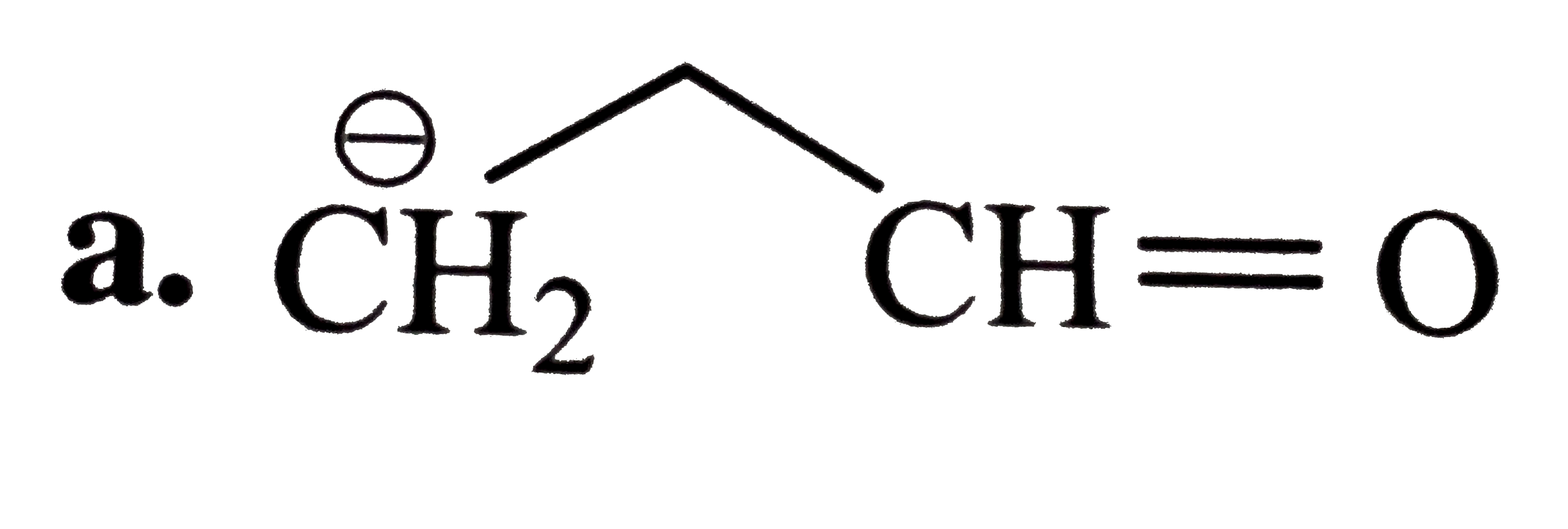Which of the following are not ambident carbanions ?

ɵCH2−CH=O


The correct Answer is:A, C
To determine which of the given options are not ambident carbanions, we need to analyze each option based on the criteria for ambident carbanions. An ambident carbanion is characterized by the following:
1. The carbanion must be capable of resonance.
2. There should be more than one different canonical structure.
Now, let's analyze each option step by step.
Step 1: Analyze Option A (CH2-)
- Structure: CH2- has a negative charge on carbon.
- Resonance: There are no conjugate double bonds or other atoms that can stabilize the negative charge through resonance.
- Conclusion: Since there is no resonance, this is not an ambident carbanion.
Step 2: Analyze Option B (CH2=O-)
- Structure: CH2=O- has a double bond between carbon and oxygen, with a negative charge on carbon.
- Resonance: The negative charge can be delocalized to the oxygen, forming different canonical structures (one with the negative charge on carbon and another with the negative charge on oxygen).
- Conclusion: This is an ambident carbanion because it satisfies both conditions.
Step 3: Analyze Option C
- Structure: This option has a carbanion with no conjugation near the negative charge.
- Resonance: Since there is no conjugation, resonance cannot occur.
- Conclusion: This is not an ambident carbanion.
Step 4: Analyze Option D
- Structure: This option shows a structure with conjugation present.
- Resonance: The negative charge can be delocalized, leading to different canonical structures.
- Conclusion: This is an ambident carbanion.
Final Conclusion
Based on the analysis:
- Not Ambident Carbanions: Option A (CH2-) and Option C.
- Ambident Carbanions: Option B (CH2=O-) and Option D.
Answer:
The options that are not ambident carbanions are Option A and Option C.
2. There should be more than one different canonical structure.
- Structure: CH2- has a negative charge on carbon.
- Resonance: There are no conjugate double bonds or other atoms that can stabilize the negative charge through resonance.
- Conclusion: Since there is no resonance, this is not an ambident carbanion.
- Structure: CH2=O- has a double bond between carbon and oxygen, with a negative charge on carbon.
- Resonance: The negative charge can be delocalized to the oxygen, forming different canonical structures (one with the negative charge on carbon and another with the negative charge on oxygen).
- Conclusion: This is an ambident carbanion because it satisfies both conditions.
- Structure: This option has a carbanion with no conjugation near the negative charge.
- Resonance: Since there is no conjugation, resonance cannot occur.
- Conclusion: This is not an ambident carbanion.
- Structure: This option shows a structure with conjugation present.
- Resonance: The negative charge can be delocalized, leading to different canonical structures.
- Conclusion: This is an ambident carbanion.
Based on the analysis:
- Not Ambident Carbanions: Option A (CH2-) and Option C.
- Ambident Carbanions: Option B (CH2=O-) and Option D.
The options that are not ambident carbanions are Option A and Option C.
Topper's Solved these Questions
- BOOK - CENGAGE CHEMISTRY ENGLISHCHAPTER - ALIPHATIC AND AROMATIC ALDEHYDES AND KETONESEXERCISE - Exercises Single Correct71videos
ALIPHATIC AND AROMATIC ALDEHYDES AND KETONES
- BOOK - CENGAGE CHEMISTRY ENGLISHCHAPTER - ALIPHATIC AND AROMATIC ALDEHYDES AND KETONESEXERCISE - Exercises Assertion-Reasoning6videos
ALIPHATIC AND AROMATIC ALDEHYDES AND KETONES
- BOOK - CENGAGE CHEMISTRY ENGLISHCHAPTER - ALIPHATIC AND AROMATIC ALDEHYDES AND KETONESEXERCISE - Exercises Linked Comprehension59videos
ALIPHATIC AND AROMATIC ALDEHYDES AND KETONES
- BOOK - CENGAGE CHEMISTRY ENGLISHCHAPTER - ALCOHOL,PHENOL AND ETHERSEXERCISE - Archives Analytical And Descriptive15videos
ALCOHOL,PHENOL AND ETHERS
- BOOK - CENGAGE CHEMISTRY ENGLISHCHAPTER - APPENDIX INORGANIC VOLUME 2EXERCISE - Short Answer Type179videos
APPENDIX INORGANIC VOLUME 2
Similar Questions
Knowledge Check
- Question 1 - Select One
Which one of the following is most stable carbanion ?
A B
B C
C D
D
Which of the following is not true for carbanions ?
View SolutionWhich of the following is the least stable carbanion?
View SolutionWhich of the following reactions involve carbanion enolalte as reactive intermediate?
View SolutionReaction intermdiates are short lived species and are highly reactive. They are formed by heterolytic and homolytic bond fission. There are various types of reaction intermediates in which the most important are carbocation , carbanion and free radical.
Carbocation is an organic species in which carbon have positive charge and six electrons in its outermost shell. The stability of carbocation can be increased by positive inductive effect, hyperconjugation and delocalisation. If α-atom with respect to carbocation has one or more lone pair of electron then lone pair of electron strongly stabilises the carbocation due to octet completion.
Species in which carbon have negative charge is called carbanion. Carbanion carries three bond pairs and one lone pair. The stability of carbanion can be increased by negative inductive effect, negative mesomeric effect and delocalisation.
Free radical is a species which have seven electrons in its outermost shell. The stability of free radical can be increased by hyperconjugation and delocalisation.
Which of the following is the most stable carbanion intermediate ?View SolutionWhich of the following is aromatic carbanion?
View SolutionWhich of the following is not an ambident nucleophile?
View SolutionWhich of the following compounds can form carbanion easily ?
I. CH3CH2 II. CH3CHO III. CH3CH2Cl IV.
The correct choice is :View Solution
